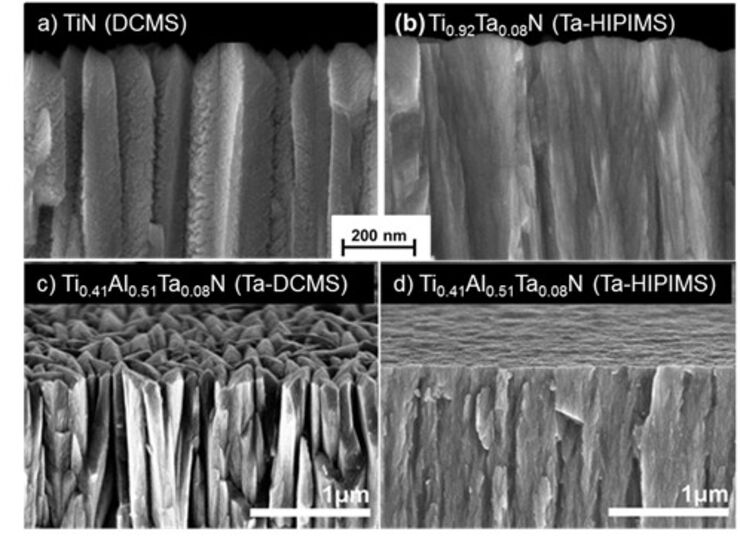This project addresses the issue of efficient energy and resource consumption in industrial processes, which has been defined by United Nations as one of the sustainable development goals. We use our expertise in physical vapor deposition (PVD) to develop new processing routes for production of functional coatings on cutting tools with significantly reduced power consumption (eco-PVD).
An important advantage of PVD technology is that it is more environmentally friendly than tradi-tional coating processes such as electroplating or chemical vapor deposition. PVD is clean and dry, with no hazardous materials, and does not generate chemicals. Nevertheless, PVD consumes large amounts of energy. This is primarily due to the fact that most coatings are deposited at elevated temperatures, Ts/Tm > 0.3 (Ts and Tm: growth and melting temperatures in K) corresponding to Ts > 900 °C for TiN to ensure sufficient adatom mobility. Films grown with no external heating are un-derdense (see Fig. 1(a)-(c)) and exhibit poor mechanical and optical properties with high resistivity. The classic solution is to employ gas-ion (e.g., Ar+ and N2+) bombardment to densify the films. This allows for lowering Ts to 400-500 °C at the expense of higher compressive stress, due to significant concentrations of trapped gas atoms, which is highly undesired as it results in cohesive film failure and delamination. As a consequence, typical PVD process requires hours of system preheating and intense cooling to protect temperature-sensitive components. For example, a research system in our laboratory uses 20 kW with a cooling water flow of 100 l/min.
Our approach relies on the paradigm-changing idea of replacing the conventionally used ther-mal energy flux from resistive heaters with the irradiation by high mass metal ions, which results in more efficient energy transfer to the deposited layer. Project capitalizes on recent advances in the field of magnetron sputtering such as high-power impulse magnetron sputtering (HiPIMS), which serves as the source of metal ions. The metal-ion mass, incident flux, and impact energy can be independently and synchronously controlled in our novel hybrid HiPIMS/DCMS deposition sys-tem. , , ,
Preliminary results using Ta+ metal-ion irradiation during low-Ts DCMS growth (< 120 °C, see SEM images in Fig. 1) reveal dramatic effect on the film microstructure. Extreme porosity in reference TiN (Fig. 1(a)) and Ta-DCMS Ti0.41Al0.51Ta0.08N (Fig. 1(c)), characteristic of low-Ts growth, is evident and results in poor mechanical properties. With pulsed Ta+ ion irradiation, inter- and intracolumnar porosity is eliminated (Figs. 1(b) and 1(d)). Film hardness depends on the incident Ta+ energy and is 330 % higher than for the reference DCMS layers, while the residual stress is low.4,5
The ultimate project goal is 50% reduction of power consumption by completely eliminating sub-strate heating requirements. Additional benefits include (i) improved PVD economics due to short-er operational cycles as heating/cooling times are eliminated, and (ii) the ability to coat on temper-ature-sensitive substrates.
 Towards environment-friendly physical vapor deposition (eco-PVD) of advanced functional coatings and better understanding of heavy-metal-ion/surface Fig. 1 XSEM images showing the effect of metal ion bombardment on the nanostructure of TiN and TiAlN films grown with no external heating (Ts < 120 °C). TiN (a) and TiAlTaN (b) films grown with DCMS show extremely open columnar structure characteristic of a low Ts growth. In contrast, TiTaN (c) and TiAlTaN (d) layers grown with synchronous 160 eV Ta+ bom-bardment from HiPIMS target are fully dense with only 4 at% Ta added.
Towards environment-friendly physical vapor deposition (eco-PVD) of advanced functional coatings and better understanding of heavy-metal-ion/surface Fig. 1 XSEM images showing the effect of metal ion bombardment on the nanostructure of TiN and TiAlN films grown with no external heating (Ts < 120 °C). TiN (a) and TiAlTaN (b) films grown with DCMS show extremely open columnar structure characteristic of a low Ts growth. In contrast, TiTaN (c) and TiAlTaN (d) layers grown with synchronous 160 eV Ta+ bom-bardment from HiPIMS target are fully dense with only 4 at% Ta added.
V. Kouznetsov, K. Macak, J.M. Schneider, U. Helmersson and I. Petrov, Surf. Coat. Technol. 122 (1999) 290
G. Greczynski, I. Petrov, J.E. Greene, L. Hultman, J. Vac. Sci. Technol. A 37 (2019) 060801
G. Greczynski, S. Mráz, J.M. Schneider, L. Hultman, J. Appl. Phys. 127 (2020) 180901
G. Greczynski, J. Lu, I. Petrov, J.E. Greene, …, L. Hultman, J. Vac. Sci. Technol. A 32 (2014) 041515
H. Fager, …., J. E. Greene, L. Hultman, I. Petrov, G. Greczynski, J. Appl. Phys. 121 (2017) 171902
Contact Principal Investigator:
Grzegorz Greczynski
